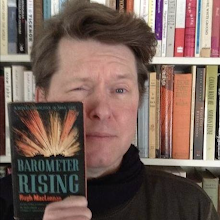The Weak-Eyed Bat
Collected Millar: The First Detectives
Margaret Millar
New York: Syndicate, 2017
My aunt and uncle had a cottage on Bell's Lake, not far from Markdale, Ontario. I have memories of visiting as a child. Our journeys there would begin with the loading of the family Volkswagen Squareback in Montreal. The final leg had us on a narrow dirt lane at the end of which were four other cottages. I thought of these summer retreats while reading The Weak-Eyed Bat. Millar's setting is Ontario's Muskokas, roughly 150 kilometres northeast of Bells Lake, but it seemed very familiar.
The Weak-Eyed Bat was Margaret Millar's second novel. It followed The Invisible Worm, which I read five years ago. I didn't like The Invisible Worm, and really disliked Paul Prye, its protagonist psychologist/sleuth. Prye makes his return here, hence this delayed visit to cottage country.
I'm glad I made the journey.
The Weak-Eyed Bat takes place within a small isolated grouping of summer homes like the ones on Bell's Lake, the exception being a large house belonging to Emily Bonner. A man of modest means such as myself might consider it a mansion. Unlike the neighbouring cottages, this Musoka residence is occupied year-round. Miss Bonner lives there, as do nephew Ralph and two servants. At twenty-three, Ralph has a hankering to "go out into the world," but Aunt Emily holds the purse strings. Remarkably, given his milquetoast demeanor, Ralph has proposed to summer neighbour Joan Frost, daughter of classical Greek scholar Professor Henry Frost. Joan's acceptance has everything to do with the aforementioned Bonner purse; she is very aware that it will one day come into Ralph's hands. In the meantime, eighteen-year-old Joan is happy to carry on with Tom Little. Another neighbour, middle-aged Tom had himself married for money. Since that time, plain Jane wife Mary has endured years of infidelity and, as seems appropriate, developed a severe heart ailment.
These are but five of the cast of characters living within this small community; Other residents include: Susan Frost (Joan's half-sister), Miss Alfonse (Emily Bonner's nurse), Jeanette (Mary Little's nurse/housekeeper), Nora Shane (a landscape painter), a "Mr Smith," and, of course, Paul Prye.
These are but five of the cast of characters living within this small community; Other residents include: Susan Frost (Joan's half-sister), Miss Alfonse (Emily Bonner's nurse), Jeanette (Mary Little's nurse/housekeeper), Nora Shane (a landscape painter), a "Mr Smith," and, of course, Paul Prye.
This Paul Prye is a different man than the one introduced in The Invisible Worm. Much of what made his so irritating in his debut is gone. He no longer quotes Blake. Prye does quote Browning's 'Andrea del Sarto,' the source of the title, but that's nearly it:
Too live the life grew, golden and not grey,And I’m the weak-eyed bat no sun should temptOut of the grange whose four walls make his world.How could it end in any other way?
Current publisher Syndicate does a disservice in describing Prye as a "poetry-quoting psychologist."
That was the old Prye.
The Weak-Eyed Bat is nowhere near the best of Margaret Millar, but it is worthy of attention in that it shows Millar becoming Millar. Things unfold more slowly than in her debut. It isn't until the last sentence of the fourth chapter (of eighteen) that the reader learns a character has died. The end of chapter five gives some suggestion as to who it might be. The identity is revealed in the sixth chapter, accompanied by evidence that the character has been murdered.
These discoveries come a touch early for a Margaret Millar novel, but then The Weak-Eyed Bat was only her second. She was finding her legs.
Still, it is long enough for Millar to introduce and flesh out and make memorable characters, no matter how minor. My favourite is Emily Bonner, in part because she pretends to be much older than her 65 years so as to receive compliments on her appearance.
It's a neat trick.
Must remember it if I ever find myself swimming again at Bell's Lake.
Must remember it if I ever find myself swimming again at Bell's Lake.
Trivia: As with The Invisible Worm, the contract for The Weak-Eyed Bat names husband Kenneth Millar as co-author.
Object and Access: The Weak-Eyed Bat was first published in 1942 by Doubleday. It reappeared two years later in Two Complete Detective Books magazine (May 1944). A Spanish translation, El murciélago miope, which Google translates as "The Myopic Bat," was published by Club del Misterio in 1948.
And that was it until 2017 when it was returned to print beside The Invisible Worm, The Devil Loves Me, Wall of Eyes, and The Iron Gates in the first volume of the Collected Millar.



















